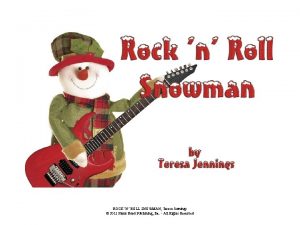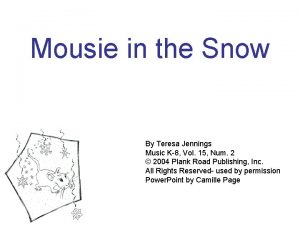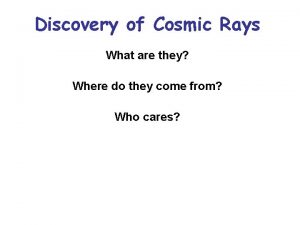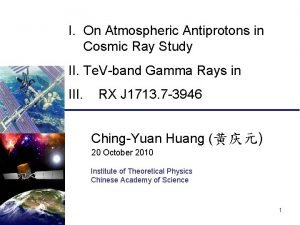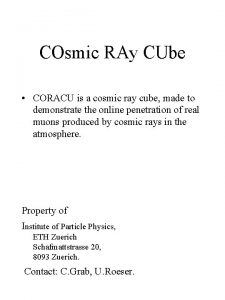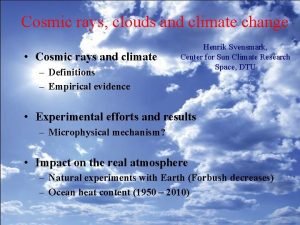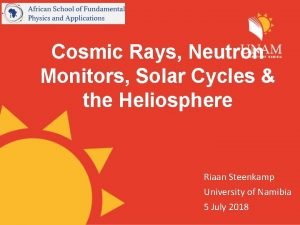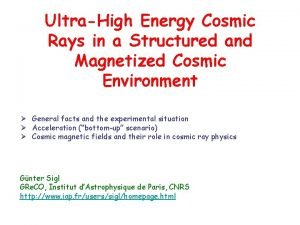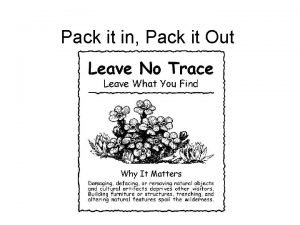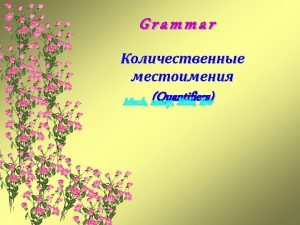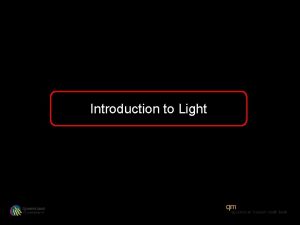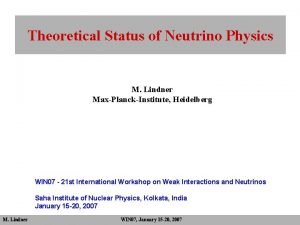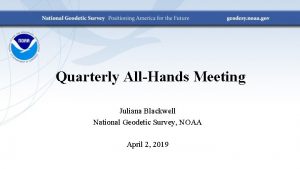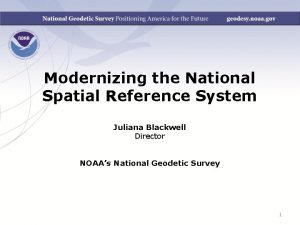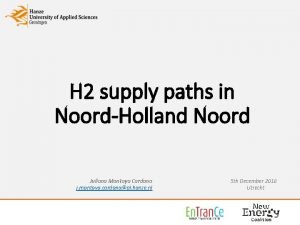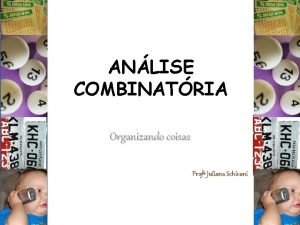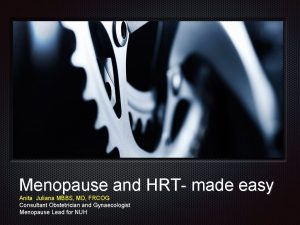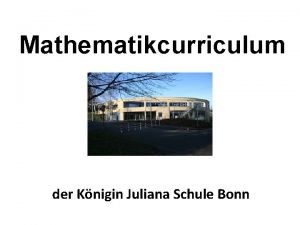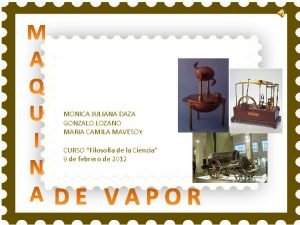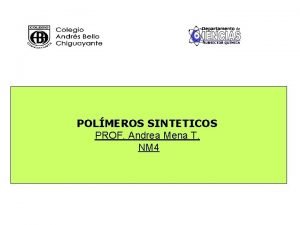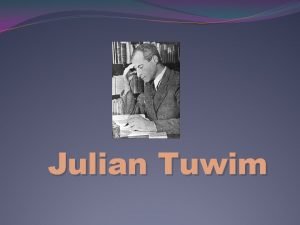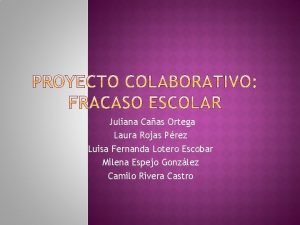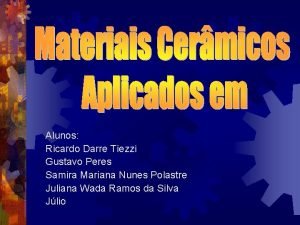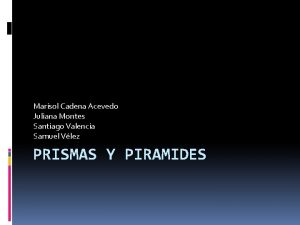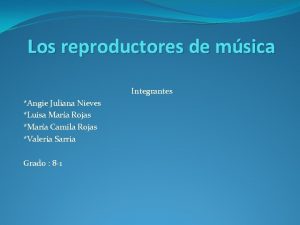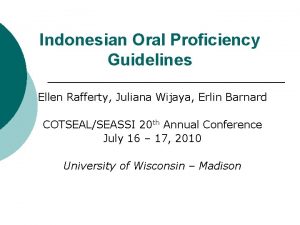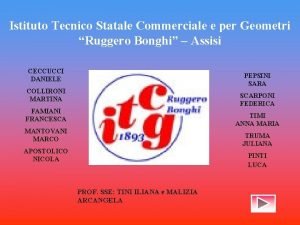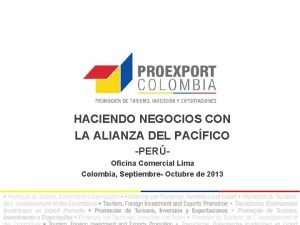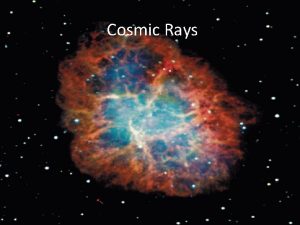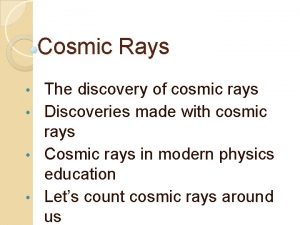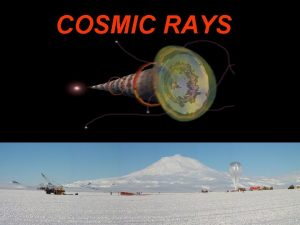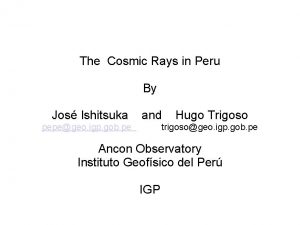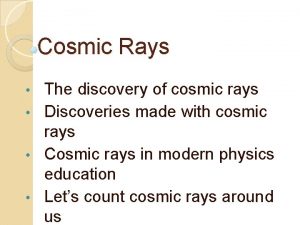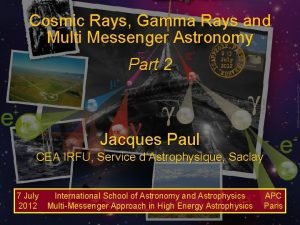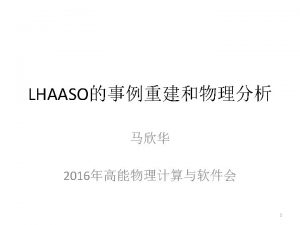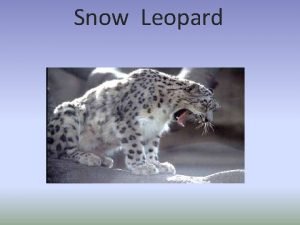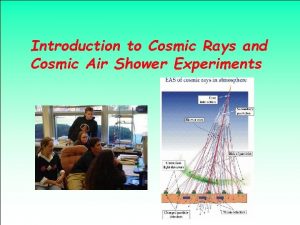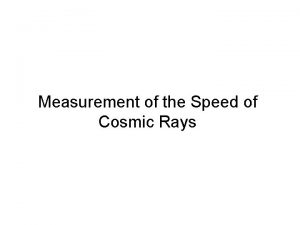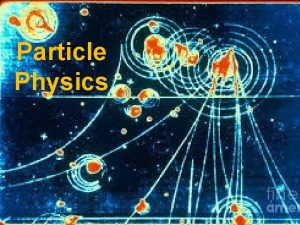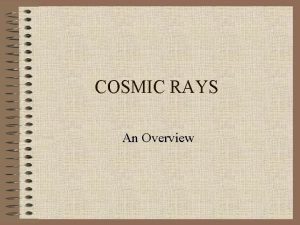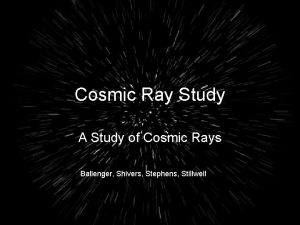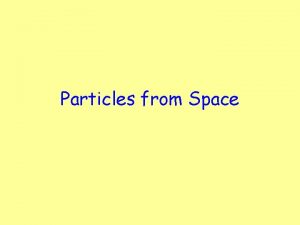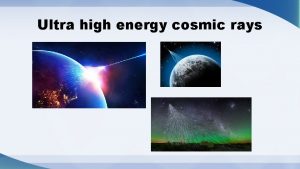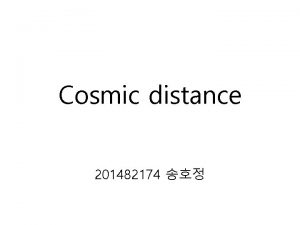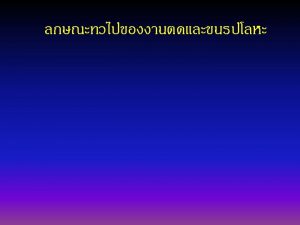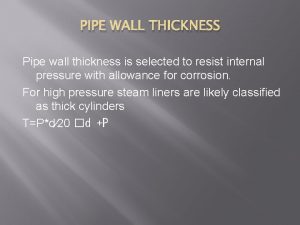Measuring Snow Pack Thickness Using Cosmic Rays Juliana



































- Slides: 35

Measuring Snow Pack Thickness Using Cosmic Rays Juliana Araujo March 11, 2004

Outline l l l Introduction Some definitions Previous attempts to measure snow water equivalent (SWE) Thermal & Epithermal Neutrons Conclusion

Introduction l l Cosmic rays neutrons have been a topic of studies for many years. They are useful in quantifying production of isotopes, such as 36 Cl. Safe alternative to g-rays from highly radioactive 60 Co, commonly used in snow gauge

Introduction l l Measuring snow pack thickness and SWE is of great importance for river forecasting and water resources planning. Automation for remote areas: l l snow pillows radio nuclear devices, l l l Attenuation of g-rays in snow monitoring of attenuation of natural isotopes in snow profiling snow density through back scattering X-rays

Topics of Discussion Previous Attempts l l l Bissell 1974 Kodama 1975 Kodama 1980 New Technique Experiment Basic Theory Equipment Similarities Unanswered questions Thermal & Epithermal Neutrons Purpose Goals Some Preliminary results

Some Definitions l Thermal, Epithermal, Fast, and High-energy neutrons l Thermal Neutrons: l l l Epithermal Neutrons: l l Those between thermal range and 1 e. V Fast Neutrons: l l Practically, the Cd-cutoff range Neutrons with an energy <0. 6 e. V Those that are produced in the atmosphere, due to secondary cascade, through ‘evaporation-like’ process from nuclear interactions of nuclear active particles with higher energies. Some say, 1 e. V-100 Kev, while others define as <10 Me. V. The energy spectrum peaks at 1 Me. V for fast neutrons. High Energy neutrons: l Those produced from primary cosmic rays, E > 10 Me. V

More Definitions l “evaporation” & “ground albedo” neutrons l These are slow neutrons produced in the soil, and escape back into the atmosphere, where it is absorbed by the 14 N(n, p)14 C reaction (Hendrick & Edge, 1966) l l ‘Neutrons that are created into the soil and are backscattered from soil to air’ (Kodama 1980) Function of soil moisture content due to diffusion and absorption of “albedo” neutrons.

Bissell, 1974 l l l Deep Snow Measurements Highly penetrating cosmic radiation Counts are produced by Na. I(TI) scintillator, grays are >3 Me. V High-energy, to ensure that what they detect is entirely produced by comic radiation The detectors function primarily by photons generated by cosmic interaction with nuclei in air, water, soil, and in the system.

Bissell, 1974 Lake Mead, Nevada l test dampening effect in the flux due to water at various depths l buried one detector in soil and other, suspended above snow Counts/min >3 Me. V, in 10 cm. X 10 cm scintillator as function of water depth

Bissell, 1974

Bissell, 1974 Underground detector l counts >3 Me. V flux as attenuated by snow cover l <3 Me. V g-flux from radioisotopes in soil, and soil moisture near detector Suspended detector l >3 Me. V fluxes “unattenuated” by snow l <3 Me. V natural terrestrial g-radiation attenuated by snow l serves as a control from barometric pressures, seasonal and solar variations

l l l Preliminary Test to investigate absorption effects of neutrons in water. Type A and WS detector with counting rates ~170 -300 n/hr in Tokyo T can be accurate to a % of the depth, with one measurement per day Kodama, 1975 Water absorptions of neutrons in Tokyo, compared with 60 Co measurements of g-rays.

Kodama, 1975 Mt. Norikura (2, 770 m) l One detector was placed inside a snowfree building l The other placed on the ground l The difference in counts from the two detectors with use of empirical curve water equivalent of snow pile Experimental error based on counting rates to measuring time and snow depth

Kodama, 1975 1974 November December water equiv. (depth, cm) neutrons counts/hr a) barometric pressure b) indoor c) outdoor d) water depth Date Time profile of neutron counting rates. Snow fall

Kodama, 1980 l l Winter season of 1977 -1978 Estimated to be effective for deep snow, >1 m Only have statistical errors due to n-counting, and change in moisture content in soil Goal: l how cosmic-gauge is useful on continuous observations of SWE.

Kodama, 1980 Experiment: l l Takada, 13 m a. s. l. Hirosaki (302 m) Oritate, 1330 m Ohtawa, 1440 m (1) Nw =Noexp(1 -0. 753(1 -exp(-0. 77 w))); w<30 cm (2) Nw = N 30 exp(1 -0. 00578(w-30)); w>30 cm (3) w 1=13 ln(0. 753/(0. 753 -ln(No/ Nw))), cm (4) w 2=173 ln(N 30/Nw) if w 1>30 cm Instrumentation: l l moderated BF 3 counter, 2 cm polyethylene constant response in 1 ev-1 Me. V range two sensors, WS, and HP After corrections for barometric pressures they used the following to convert the counts to water equivalents:

Kodama, 1980

Kodama, 1980 l Correlation between barometric pressure and cosmic ray neutron flux, under snow

Kodama, 1980 l l Good correlation between cosmic-ray gauge, and snow sampler, except near the snow cover maximum due to discordance or field discrepancies Atmospheric pressure effects, varies with barometric pressure The greater the snow cover depth, the harder the energy spectrum Primary Cosmic ray modulation l l daily variations affects the apparent swe of snow pack Statistical Fluctuations

Conclusions from the past l l l All three experiments are used for high energy neutrons. Whether they use g-ray or neutrons, they measure these effects under snow shielding Related to the attenuation of neutrons in the snow, and moisture in soil. l l They do not look at lower energies. As in the case of Kodama 1980, the method was successful for long term measurements, and can be used for deep snow packs

The new technique l l l Uses thermal and epithermal neutrons, as means to quantify moisture in the soil, and possibly applicable to snow pack thickness Unique, because there has been no previous work of this nature, with thermal neutrons My definition: l l Thermal neutrons: 0 -0. 6 e. V Epithermal neutrons: 0. 6 -100 Ke. V

The new technique Desilets—Personal Communication Depth in concrete (g/cm 2) Comparison of depth profiles for measured and calculated thermal neutron fluxes.

The new Technique Fig. 1: Comparison of epithermal and thermal neutron fluxes in a concrete block at Los Alamos National Laboratory Scalable— volume could be corrected by adjusting the height of the instrument * F. M Phillips et al. , 2000. l

The new technique l Speculation: l l Snow pack depresses neutron flux Along with ponding, it could significantly skew the count rates of thermal neutrons. Fig. 8. Approximate neutron density near a water surface *Edge, R. D. 1958

l l Fig. 3 a. Epithermal neutron flux as a function of water content (%) Fig. 3 b. Thermal neutron flux as a function of water content. The thermal flux data of Hendrick and Edge 1966 are shown for comparison. * F. M Phillips et al. , 2000.

What This Means l Made-up Basalt l l varying water content, 3%, 20%, 40% varying amount of water on top of saturated soil, 5 cm, 10 cm, and 20 cm of water. Results are a good indication that we are on the right path Although, some of it still is ambiguous

Real Life Simulation, MCnp l l For a typical Montana soil, 20% water content Thermal & Epithermal above and below ground

Real Life Simulation, MCnp l l Thermal & Epithermal above and below ground 20 cm of water

Fake Basalt, variable WC Thermal Epithermal Thermal total Epithermal Thermal Epithermal total

Air/soil boundary effect Fig. 4 Slow cosmicray neutron density below water. *Edge, R. D. 1958

Variable Water Depth

Next Steps l l l Analysis of current results, what do they mean in terms of estimating snow pack thickness? Correlation to snow water equivalent? Boundary affects between air/water/soil. Function of thickness of water in between?

References: Avdyushin, S. I. , V. V. Abelentsev, E. V. Kolomeets, V. V. Oskomov, R. G. -E. Pfeffer, K. O. Syundikova, and S. D. Fridman, 1988. Estimating snow moisture reserve and soil humidity from cosmic rays. Izvestiya Akademii Nauk SSSR, Seriya Fizicheskaya 52, 2454 -2456. Bissell, V. C. , and Z. G. Burson, 1974. Deep snow measurements suggested using cosmic radiation. Water Resources Research 10, 1243 -1244. Kodama, M. , S. Kawasaki, and M. Wada, 1975. A cosmic-ray snow gauge. International Journal of Applied Radiation and Isotopes 26, 774 -775. Kodama, M. , 1980. Continuous monitoring of snow water equivalent using cosmic ray neutrons. Cold Regions Science and Technology, 3: 295 -303.

Above ground 20% 3% 40%

Thermal & Epithermal 40% 3% 20% 3% 40%
 Rock and roll snowman
Rock and roll snowman Snow teresa jennings
Snow teresa jennings Cosmic rays discoverer
Cosmic rays discoverer Cosmic waves
Cosmic waves Cosmic rays
Cosmic rays Svensmark
Svensmark Cosmic rays
Cosmic rays Cosmic rays
Cosmic rays Pack in, pack out
Pack in, pack out Few snow or little snow
Few snow or little snow Introduction of light
Introduction of light Golfhotel juliana
Golfhotel juliana Juliana blackwell
Juliana blackwell Juliana blackwell
Juliana blackwell Juliana montoya cardona
Juliana montoya cardona Analise combinatoria sem repetição
Analise combinatoria sem repetição Anita juliana
Anita juliana Juliana schivani ifrn
Juliana schivani ifrn Juliana schivani ifrn
Juliana schivani ifrn Königin juliana schule bonn
Königin juliana schule bonn Juliana daza
Juliana daza Son características de un polímero
Son características de un polímero Kim byl julian tuwim
Kim byl julian tuwim Juliana schivani
Juliana schivani Lotero juliana
Lotero juliana Mariana polastre
Mariana polastre Juliana valencia montes
Juliana valencia montes Formula da mediana
Formula da mediana Longvit
Longvit Juliana nieves
Juliana nieves Dr. juliana wijaya
Dr. juliana wijaya Julianausugav
Julianausugav Juliana truma
Juliana truma Polinômio
Polinômio Juliana villegas restrepo
Juliana villegas restrepo Desvio padrão excel
Desvio padrão excel
